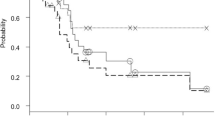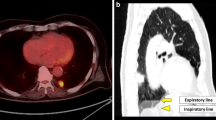Abstract
We reported a special case of a locally advanced squamous cell carcinoma of the left lung. Due to pulmonary tuberculosis, the patient had underwent a complete right-side pulmonary lobectomy 20 years ago. Left lung supports his life, he is unable to carry on an operation treatment, so he accepted radiotherapy. Firstly, we defined gross tumor volume (GTV1) by CT simulation location, three-dimensional conformal radiotherapy (3D-CRT) was used until tumor dose reached 50 Gy/25 f. Secondly, by repeating the planning CT scan, defined GTV2, continued to radiotherapy by 2.5 Gy/f until the dose was 65 Gy/31 f. Using the same method for third CT scan, defined GTV3, continued to radiotherapy by 3 Gy/f until the total dose was 74 Gy/34 f. After radiotherapy, the patient acquired complete response and he had no obvious side-effect of radiotherapy. There has been no recurrence for 5 years now.
Similar content being viewed by others
References
Bradley J, Graham MV, Winter K, et al. Toxicity and outcome results of RTOG 9311: a phase I–II dose-escalation study using three-dimensional conformal radiotherapy in patients with inoperable nonsmall-cell lung carcinoma. Int J Radiat Oncol Biol Phys, 2005, 61: 318–328.
Erridge SC, Seppenwoolde Y, Muller SH, et al. Portal imaging to assess set-up errors, tumor motion and tumor shrinkage during conformal radiotherapy of non-small-cell lung cancer. Radiother Oncol, 2003, 66: 75–85.
Britton KR, Starkschall G, Tucker SL, et al. Assessment of gross tumor volume regression and motion changes during radiotherapy for non-small-cell lung cancer as measured by four-dimensional computed tomography. Int J Radiat Oncol Biol Phys, 2007, 68: 1036–1046.
Ramsey CR, Langen KM, Kupelian PA, et al. A technique for adaptive image-guided helical tomotherapy for lung cancer. Int J Radiat Oncol Biol Phys, 2006, 64: 1237–1244.
Woodford C, Yartsev S, Dar AR, et al. Adaptive radiotherapy planning on decreasing gross tumor volumes as seen on megavoltage computed tomography images. Int J Radiat Oncol Biol Phys, 2007, 69: 1316–1322.
Engelsman M, Remeijer P, van Herk M, et al. Field size reduction enables iso-NTCP escalation of tumor control probability for irradiation of lung tumors. Int J Radiat Oncol Biol Phys, 2001, 51: 1290–1298.
Feng M, Kong FM, Gross M, et al. Using fluorodeoxyglucose positron emission tomography to assess tumor volume during radiotherapy for non-small-cell lung cancer and its potential impact on adaptive dose escalation and normal tissue sparing. Int J Radiat Oncol Biol Phys, 2009, 73: 1228–1234.
Author information
Authors and Affiliations
Corresponding author
Rights and permissions
About this article
Cite this article
Cheng, S., Fu, Z. & Gu, T. Late course shrinking gross tumor volume (GTV) and boost radiotherapy for a special left lung cancer patient whose right lung was resected: a case report. Chin. -Ger. J. Clin. Oncol. 11, 665–667 (2012). https://doi.org/10.1007/s10330-012-1075-9
Received:
Revised:
Accepted:
Published:
Issue Date:
DOI: https://doi.org/10.1007/s10330-012-1075-9




